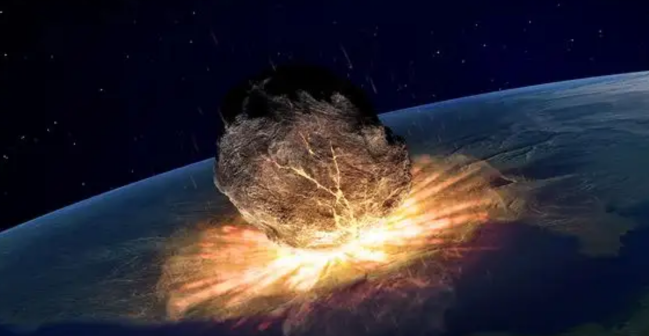If an asteroid hits the Earth, is it feasible to build a fort five kilometers underground to avoid it?
Scientists plan to hit a space asteroid in September. Will it hit Earth?
What would humanity do if an asteroid the size of four Eiffel Towers was heading for Earth and would soon crash into our planet, destroying all life on Earth? It's a fantasy, of course, but that doesn't mean it can't happen.
66.5 million years ago, a huge asteroid slammed into our planet and wiped out dinosaur history. If a diameter of 12 km an asteroid hit the earth, the earth's atmosphere would not be able to slow the speed of space objects, more than 600 mm in diameter, eventually on earth left a crater 170 km wide, and then broken into hundreds of rock fragments, the outbreak of the energy will instantly evaporation destroyed hundreds of kilometers around all of the buildings, The violent explosion wave will trigger a huge tsunami around the Earth, which will destroy the remaining buildings, but that's not the worst of it. Because the main danger is not the asteroid itself, but debris from the explosion.
The remnants of large rocks and meteorites created by the explosion can fly up to 70 kilometers, and they will return to Earth about 40 minutes after the explosion! Thousands of tiny meteorites would burn in the atmosphere and rapidly heat the planet. This will lead to a fire and destroy all life around. Scientists estimate that 66 million years ago, dinosaurs were the last fragments and heat mass extinction. If it happened in our time, millions of people would die of meteorites fall fire, so the question comes. How likely is it that one of these asteroids will hit Earth? I'm sure that's what most people care about!39bet-đua chó-game giải trí -đá gà-đá gà trực tuyến-đánh bài
NASA experts say that the huge asteroid impacts the risk is extremely great, which is why the United States congress in 1992. NASA has set a target for that in the next 25 years. They have to detect larger than one kilometer of 90 neos, because such asteroids may cause serious damage in thousands of kilometers radius. Even worse, it could disrupt communications and even satellite navigation.
Today, space is monitored by dozens of different programs. They've found about 50 NEOs that are around 140 meters in diameter. That number will soon rise with NASA's plans to launch the Near-Earth Object Explorer infrared telescope. It will record all near-Earth objects larger than 140 meters within a radius of 1 million kilometers from Earth's orbit. The instrument will be equipped with two heat-sensitive infrared channels, meaning it will be able not only to detect the asteroid, but also to measure its exact size, find out its exact composition, and calculate its speed and trajectory.
 In fact, the first thing scientists learn to do is destroy an asteroid before it enters the atmosphere, for example by blowing it up with a nuclear device, but think twice before launching a nuclear warhead into space. After all, this strategy is similar to that of asteroid debris, which could still fall to Earth and cause destruction, but there is another way to deflect an asteroid from its path, away from our planet.
In fact, the first thing scientists learn to do is destroy an asteroid before it enters the atmosphere, for example by blowing it up with a nuclear device, but think twice before launching a nuclear warhead into space. After all, this strategy is similar to that of asteroid debris, which could still fall to Earth and cause destruction, but there is another way to deflect an asteroid from its path, away from our planet.
NASA has launched the first DART training mission, which will test the spacecraft by crashing into an asteroid. In September, scientists will attempt to deflect it from its original trajectory. If successful, it could be an effective way to protect Earth from an asteroid that's only 170 meters in diameter, and the DART spacecraft that crashed into it weighed merely 610 kilograms. If it took us to shoot down the dinosaur-destroying asteroid, we need to create a force 70 times greater than that.
In addition to defense in space, some people have proposed building fortresses below the surface, about five kilometers underground, and clearly, there's not enough room in such fortresses for everyone. But you also can't stay in the fort for a long time and then go back to your daily life, because after the fire, ash and dust particles will float in the atmosphere for 10 years, totally blocking sunlight, so the temperature on Earth will immediately drop by around 28 degrees and all plants will die. Then came herbivores, and finally carnivores. Only those who are prepared will survive.
For example, feathered dinosaurs began to die out and evolved into birds long before the asteroid impact, and that's what saved their lives. These animals were considerably smaller than their dinosaur counterparts, meaning they didn't need as much food to survive soon before the asteroid impact. Some of them grew beaks and became omnivorous, feeding on insects, plant seeds, nuts, and any additional food they could find. People also need to be prepared for the possibility that the food in the bunker will run out soon. The main problem is that without sunlight, we won't be able to grow plants and farm animals. The only things that can grow in the ground are mushrooms. So if you want to survive, you have two choices. The first option is to follow the example of feathered dinosaurs and become completely omnivorous.
Elon Musk thinks a huge asteroid will hit Earth again one day, and so far, we have no protection. What are your plans if this happens?